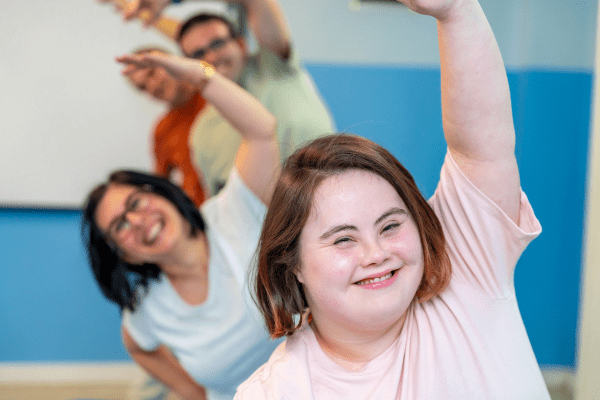Move your body to feel great
Let’s talk about movement
I know that even hearing the word ‘exercise’ can sometimes feel overwhelming, something we know we ‘should’ be doing but don’t always have the energy for.
At the end of a long day, this can leave us feeling like it doesn’t seem like a priority…
What I find quite helpful, is to be reminded that energy and motivation come at the end – after moving our bodies.
Another little tip to remember is to proactively change focus and think about not only the physical but also mental/emotional benefits that movement can bring. Shifting focus away from worrying about how the body needs to look a certain way, to – focusing on how we feel and that we want the body to function as effectively as it can.
Movement for Wellbeing
Moving your body is good for your physical, mental and emotional wellbeing and here’s why….
- Brain Health – more blood and oxygen is pumped into the brain when you exercise which triggers the production of hormones that help more brain cells to grow. Research shows that physical activity improves your cognitive performance (at any age) and can help improve mental acuity, reaction times, focus and decision making.
- Mood Booster – moving your body improves your mood by stimulating feel good and reward hormones (serotonin and dopamine) and reducing the stress hormone (cortisol). This helps you to feel happier, more relaxed, less anxious and more self-confident. Regular physical activity can also help you to cope much better with stress and as your body will be able to switch back to the parasympathetic state (rest and digest) much more quickly.
- Sound Sleep – regular physical activity can help you fall asleep faster, get better sleep and deepen your sleep. The energy depletion that happens when you exercise stimulates a recuperative process during sleep (your cells repair more successfully). Interestingly, exercise also supports your body temperature to drop during sleep which improves sleep quality. Please note – it’s not a good idea to exercise too close to bedtime as you might feel far too energised to nod off!
- Bone and Muscle Health – as we get older we experience a loss in bone density and this can make us much more susceptible to fractures. Exercise causes muscles to push and pull against your bones and this is what helps to build and preserve bone mass. It also releases hormones that promote the ability of muscles to grow and reduces the likelihood of falls because your balance is improved.
- Immune Health – the lymphatic system is part of the body’s immune system and as it doesn’t have its own ‘pump’ it relies on movement to work properly. Lymph fluid, which helps to fight infection and remove toxins and bad bacteria from the body, is pumped around the body when you move your large muscles (e.g. in your legs!).
- Health Conditions – regular physical activity boosts your good cholesterol (high-density lipoprotein cholesterol – HDL) and decreases unhealthy triglycerides which reduces your risk of cardiovascular diseases. In addition, being active can help to reduce the risk of, and help manage, many long-term conditions or illnesses such as diabetes, high blood pressure, stroke, asthma, anxiety, depression and dementia.
- Pain Reduction – exercise may help to reduce inflammation, increase mobility and decrease pain levels. It’s also been shown to increase your tolerance for pain and by releasing feelgood endorphins, exercise can help to change your perception of pain.
How Much Exercise?
We should all aim to be physically active every day and reduce the amount of time we spend sitting or lying down.
Adults should ideally do 150 minutes of moderate intensity exercise a week (e.g. brisk walking, cycling, swimming, golf, bowling) OR 75 minutes of more vigorous activity (e.g. jogging, football, fitness classes, high intensity interval training, martial arts).
Even small amounts of physical activity are helpful – accumulated activity throughout the day/week adds up to provide health benefits.
In addition, adults should aim do some strengthening exercises twice a week – yoga, pilates, working with resistance bands, body weight exercises (push ups / sit ups), lifting weights (carrying children counts!).
Other Ways to Move Your Body
Exercise is simply another word for movement, something our bodies were designed to do. Exercise is anything that gets your breath and heart rate up and makes you feel a bit warm.
If you can find ways to incorporate movement into your daily life in a way that feels good you’ll reap the rewards. If doing a traditional form of exercise like a fitness class or going for a jog isn’t for you, the following activities are a form of exercise in disguise!
- Dancing – apart from raising your heart rate, dance moves cleverly disguise weight-bearing exercises and help to improve your range of motion. And it’s fun!
- Gardening / Housework – you move in so many ways doing either of these – walking, squatting, carrying, reaching, and pushing/pulling. That’s all strengthening exercise.
- Play – when you’re running around after children, kicking a ball or playing with pets you can easily forget that you’re exercising – you’re focused on having fun.
- Stretching – this helps to keep your joints flexible and lubricated and move lymph fluid around the body. Try stretching while watching TV or talking on the phone.
- Exercise Snacks – if you spend a lot of time at your desk, take regular movement breaks. If you are in an office encourage team members to share an ‘exercise snack’ with you by taking a quick walk.

